International Research Journal of Engineering and Technology (IRJET) e-ISSN:2395-0056

Volume: 10 Issue: 04 | Apr 2023 www.irjet.net p-ISSN:2395-0072

International Research Journal of Engineering and Technology (IRJET) e-ISSN:2395-0056

Volume: 10 Issue: 04 | Apr 2023 www.irjet.net p-ISSN:2395-0072
1, 2, 3 Department of Mechanical Engineering, Kumaraguru College of Technology, Coimbatore.
4 Senior Engineer, Titan Company Limited, Bangalore.
5 Assistant Professor, Department of Mechanical Engineering, Kumaraguru College of Technology, Coimbatore.***
Al 7075 composites are widely used in various industrial applications. The Al 7075 alloy was reinforcedwith Si3N4 and Al2O3 at different proportions. Composites were fabricated using the stir-casting method. The reinforcements were preheatedatatemperatureofaround250oCbeforeaddingittothematrix. Thecastedcompositeis machinedandturned toobtain thefinal specimen withthe desired size. Castedspecimens wereagehardenedat various temperatures ranging from 150oC – 200oC and quenched usingwater at room temperature to improve their mechanical properties such as hardness andwearcharacteristics.Theagingperiodvariedbetween2to8hours.Further,themicro-hardnessofAs-cast andheat-treatedspecimenswerestudiedandthewearanalysiswasdoneonthespecimenwithhigherhardness.
Keywords: Aluminium 7075(Al7075), Silicon nitride (Si3N4), Alumina (Al2O3), Stir-casting, hardness, Heat treatment, Quenching, Wear analysis.
ACompositeisacombinationoftwoormoreconstituentmaterialseachhavingdistinctphysicaland chemicalproperties, which is composed of two phases namely matrix (continuous phase) and reinforcement (dispersed phase). These composites possess greater properties than their constituents. Theaerospaceindustrydemands materialswithenhanced propertiessuchashighstrength,temperature-withstandingcapability,fatigueresistance,wearresistance,etc.That’swhere composite material comes into play with greater mechanical properties than conventional materials. Aluminium matrix compositesreinforcedwith ceramicswhichareoxides,carbides,carbonates,nitrides,etc.Thisprovedtodisplay superior mechanical and physical properties that are applicable to the aerospace and automobile industry where wear has a significanteffectonthelifespanandfailureofthematerial.
R. Pramod et al. studied the wear characteristics of Al7075 reinforced with Al2O3 with the help of an Artificial Neural Network. Alumina particles of size 150 µm were added in the range of 2% – 6%wt. Itwas concluded that Aluminium composite with 6% wt. Al2O3 showed excellent wear resistance when compared to the other composite specimens [1]. Avinash Lakshmikanthan et al. conducted research onthe mechanical and tribological properties of heat-treated A357 compositereinforcedwithdual-sizedSiC.ThesizeofSiCrangedfrom140+10µmto30+5µm.Heattreatmentofcomposite is donethroughaging at varying temperatures such as 160oC, 180oC, and 200oC for 6 hours. It was inferred that all the composite specimens showed superior mechanical properties in contrast to A357 [2]. A. Pramanik et al. studied the influence of reinforcement on metal matrix composite. Al6061 matrix was reinforced with 10%wt. Al2O3. The size of Al2O3rangedfrom6to18µm.Fromthestudy,itwasprovedthatwearresistancewasimprovedinallvaryingaspectssuch as sliding speed, load, and sliding distance. Itwas also inferred that wear resistance is drastically increased by means of resisting plastic deformation[3]. E. Rajkeerthi et al. conducted research on heat-treated aluminum matrix composite reinforced with10%wt. Al2O3 to study its effect on hardness, tensile and compression properties. The aluminum 6000 series is used for the study. Heat treatment was done through quenching and precipitation hardening processes. It was concludedthattheprecipitation-hardenedspecimensdisplayedgreaterhardness when comparedtoquenchedspecimens [4]. P.S.RaghavendraRaoetal.performedastudyonthemechanicalcharacteristicsofaluminum(LM6)matrixreinforced withsiliconnitride.Thepercentageofsiliconnitriderangedfrom2to10wt.%.Itwasfoundthatagglomerationisreduced by a uniform distributionof matrix and reinforcements. It was also inferred that hardness, yield strength, and ultimate tensileweregreatlyimprovedwhencomparedtothematrixalloybutwithreducedductility[5].
International Research Journal of Engineering and Technology (IRJET) e-ISSN:2395-0056

Volume: 10 Issue: 04 | Apr 2023 www.irjet.net
AstudyontheinfluenceofquenchingheattreatmentonhardnesspropertieswascarriedoutbyHammarIlhamAkbaretal. They used AL6061 composite reinforced with Al2O3. The proportion of Al2O3 was10 wt.%. Quenching was done with coolingagentssuchasoil,water,andsaltsolution(Brine).Itwasfoundthatthecoolingratehasagreateffectonhardness characteristics.Itwasalsofoundthatbrine quenchingwithahighercoolingrateproduceshigherhardnessanddistortion [6].S.ArunKumar etal.fabricated an Al7075 composite reinforced with Si3N4 through stir casting to study the effect of porosity.Thereinforcementswereaddedintheproportionof4%,8%,and12%.Thespecimenswereheattreatedusinga muffle furnace at various temperatures such as 150oC,250oC, 350oC, 450oC, and550oC for 5 hours. It was inferred that porosityresultedinareductionofmechanicalpropertiestoagreaterextentwhichcanbereducedthroughheattreatment [7]. Jitendra M. Mistry et al. conducted a tribological study on heat-treated aluminum composite reinforced with Si3N4. Al7075isusedforthematrixphaseofthecomposite.Theproportionofreinforcementswas4%,8%,and12%.Fabrication wasdonethroughelectromagneticstircasting.Itwasinferredthatwearratewasinverselyproportionaltoslidingvelocity anddirectlyproportionaltoslidingdistanceandload.Reductioninwearlosswas foundwiththeincreaseinSi3N4wt.% [8]. Fazludheen Chemmala et al. conducted computer analysis on Al7075 reinforced with Si3N4 to study its mechanical characteristicssuchasHardness,Tensile,etc.Theproportionofreinforcementaddedvariedfrom2%,4%,and6%.Astudy wasalsoconductedonthefabricationofaluminumcompositesthroughstircasting.Fromthestudy,aconsiderableincrease inmechanicalpropertieswasnoticedduetotheadditionofSi3N4reinforcement[9].RavikumarNagula etal.utilizedthe Taguchi method in the process of analyzing the wear characteristics of hybrid aluminum composites. Si3N4, Sea snail shells,andRicehuskashwereusedasreinforcements.The proportionofSi3N4andseasnailshellswasvariedas2,4,and 6%wt.,whileRicehuskashpercentagewaskeptconstantat5%wt.Itwasconcludedthatslidingspeed,load,andpercentage ofreinforcementshadaconsiderableeffectonthecoefficientoffriction[10].
Flyashisregardedasagoodreinforcementforaluminiumsinceitbooststhemechanicalcharacteristicsofthemetalwhile also being very inexpensive. Conclusion: As the weight percentage of fly ash in aluminium composite increases, tensile strength,compressivestrength,andhardnessallimprove.In ordertoturnindustrialwasteintoindustrialwealth,flyash aluminium composites should be used in industry [11]. Due to its inexpensive initial cost, great foundry castability, and strong mechanical and machining qualities,ZA-27alloyisnow preferred. TheZA27 alloy/graphite particulatecomposite in this instancehas a particlesizerangeof90-150umanda compositionof0–5%. It is determinedthatastheamount of graphiteparticles inthealloyrises,thereisadropinhardnessandanincreaseinductility, UTS,andcompressivestrength afterheattreatmentat280°Cfor1to4hours[12].Here,AA606matrixmaterialand1-5%MoS2reinforcementmaterialare used to create a metal matrix composite. It is thenheated for 1 hour at 520°C, quenched in water, artificially aged for 12 hoursat180°C,andthencooledwithair.4%Mos2reinforcedcompositeshadmuchhigheryieldandtensilestrengthsthan othermaterials,buttheirpercentageofelongationpropertywaslower.Additionally,itisnotedthatafterheattreatment,the reinforcement particles are evenly dispersed [13]. Here, a 4-weight percent SiC alloy reinforced with particles with an averagesizeof650nmhasbeenstudied. Thesolutionis treatedat540Cfor6hoursaspartoftheagehardeningprocess, which is then followed by water quenching and agingat varying temperatures of 175 C, 200 C, and 225 C for soaking durations of 3, 6 h, and 9 h. SiC is added to the alloy to boost its hardness, but it does not affect the material's wear mechanism.Therateofwearisreducedasthehardnessincreases[14].2–10wt%ofTiCwasfoundintheAMMCsunder study.The2m/sslidingspeed,2kmslidingdistance,and20Nnormalloadwereusedinthewear experiments.Thewear rate was noticeably lower for the composite material compared to the matrix material, and the wear resistance of the composites increased with increasing weight percentage of TiC particles. The mechanical characteristics of the TiCreinforced compositespecimens, suchas hardness, tensile strength, and percentage elongation qualities, are superior to thoseoftheAA7075matrixmaterialinbothcases[15].
Investigated inthis articleis thefrictionand wear behaviour of heat-treatedAl 6061 alloy and Al 6061SiC-graphite. The cast6061alloyanditscompositesunderwentasolutionizingprocessforonehouratatemperatureof803K,followedbya water quench. After being quenched, the samples were aged artificially at a temperature of 448 K for varying lengths of timebetween4and8hours.Thehardness resultdemonstratesthatthecomposites'hardnessroseastheweightfraction of graphite particles decreased. Increased reinforcing has a positive impact on the metal matrix composites' wear behaviourby reducing friction and increasing wear resistance [16]. Here, Al, Ni, and Al2O3 powders were combined in different ratios to create dense coatings by low-temperature cold spraying. Aluminides werecreatedusingtwodifferent post-depositionprocesses: resistancespot welding and furnaceheating.The hardness of the coatings increased to 205.4 HV0.3. All three coatings had equivalent microhardness, with the highest value coming in at 358.4 HV0.3 [17]. In this study, the high- temperature age-hardening behaviour of an aluminum-lithium alloy reinforced with silicon carbide particulatesisreportedandcontrastedwiththatofamatrixmaterialthathasundergoneacomparable thermomechanical treatment. According to the DSC and aging results shown here, the addition of SiCpdoes not seem to alter the matrix's general precipitationprocess,although strengthis preserved for longerperiodsof timeandathigherlevels[18].Here, a basicmatrixofA356alloyisemployed,to whichAl2O3andRHAparticulates(1Wt%,2Wt%,3Wt%,4Wt%&5Wt%)are added in equal amounts as reinforcements and corrosion resistance of the generated hybrid composites. The density of
International Research Journal of Engineering and Technology (IRJET) e-ISSN:2395-0056

Volume: 10 Issue: 04 | Apr 2023 www.irjet.net
p-ISSN:2395-0072
hybrid composites made from A356 alloy reduces when RHA and Al2O3 particles in the alloy matrix rise. The heat treatmenthasasignificantimpactonthehybridcomposites'corrosionresistance[19].StircastAl6082-SiC-Gr(Al-SiC-Gr) hybrid composites' two-body abrasive wear behaviour was investigatedandcomparedtothatof its matrixalloyandSiC reinforcedcomposites.WearimprovementofAl-SiC-Grcompositesatgreaterloadandslidingdistancewas16.4%and27% inascastandT6heattreated condition, respectively. Due to the creation of a graphitic coating, which functions as a selflubricantinAl-SiC-Grcomposites,theadditionofgraphitehasbeenfoundtobeadvantageous. improvedwear resistance withanti-agingtherapy.Thismightbetheresultofintermetallicprecipitatesformingthroughouttheagingprocess[20].
A mechanical stirrer is used in the stir-casting process to create a vortex that mixes the reinforcementwith the matrix material. Due to its low cost, suitability for mass production, simplicity, nearly net shaping, and ease of composite structurecontrol,itisanappropriateprocedureforproducingmetalmatrixcomposites.
The stir-casting equipment includes a furnace, a feeder for reinforcement, and a mechanical stirrer. Theingredients are heatedandmeltedinthefurnace.Atthebottomofthefurnaceanopeningportisplacedforinstantpouring,itisneededto prevent the solid particles from settling in the bottom of the crucibleafter stirring, in order to create the vortex that facilitatesthemixingofthereinforcementmaterialsaddedtothemeltedmatrix,amechanicalstirrerisused.Theimpeller bladeandthestirringrodmakeupastirrer.Thegeometryandnumberofbladesintheimpellermightvary.Withanaxial flowpatterninthecruciblewithlesspowerconsumption.Thereinforcingpowderisfedintothemeltusingafeederthatis alsolinkedtothefurnace.Theblendedslurryisthenpouredintoapermanentmould.
Thegraphicillustratesthevariousphasesinvolvedinthestir-castingprocess.Thematrixmaterialisaddedandretainedin the bottom pouring furnace, during this time the matrix starts to melt. In order toremove moisture, contaminants, etc., simultaneouslythereinforcementsarewarmedataspecifictemperatureinadifferentfurnace.Afterthematrixmaterialis meltedatacertaintemperature,mechanicalstirringisstartedandcreatesavortex,afterwhichthefeederisincludedinthe setuptofeedreinforcementsataconstantrateintothecenterofthevortex.Thestirringprocessisthencontinuedforsome time. The liquid mixture is then put into a mould and let to cool down and solidify naturally. Additionally, post-casting procedureslikeheattreatment,machining,testing,andinspectionhavebeencarriedout.



The moulted material is cut into pieces according to the required number of specimens which are required for all the testingprocedures. Theappropriatematerialshouldbecompatiblewiththelatheandthedesiredspecifications. Oncethe materialisplacedinthelathe,itissecuredusingachuckoracollet.ACentrelatheisusedfortheprocess.Thenextstepis tosetthecuttingtoolatthecorrectangleandposition,whichisdeterminedbythedesiredshapeandsizeofthespecimen. Thecuttingtoolisthenbroughtintocontactwiththematerial,andthelatheisturnedon.Thecuttingtoolisusedtoremove theexcess material from the specimen, gradually shaping it into the desired form. Careful attention must be paid to the speed and feed of the lathe, as well as the depth of cut, to ensure that the specimen is shapedaccurately andsmoothly. Finally, thespecimen is removedfromthelatheandinspectedfor anydefectsor imperfections. Ifthespecimen is perfect thenthespecimenisreadytobetested.Thesampleswere10mmindiameterand30mminlength.
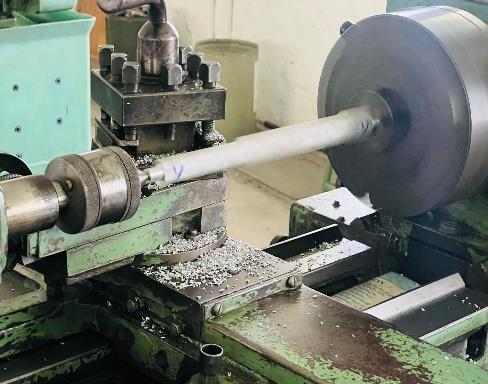
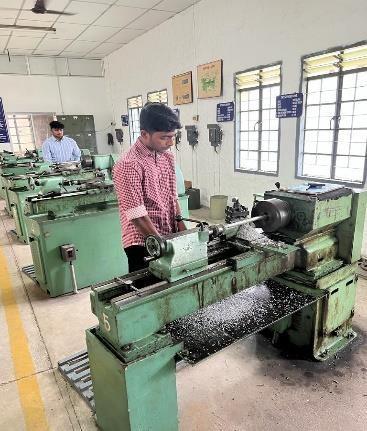



Vickers hardness test is a method used to measure the hardness of a material. It involves indenting the surface of the material with a diamond indenter in the shape of a square-based pyramid with a 136- degree angle between opposite faces. The hardness is determined by measuring the diagonal length of theindentationleft onthe material's surface. To performaVickershardnesstest,thesampleisprepared bypolishingittoamirror-likefinish.Thematerialisthenplaced onthestageoftheVickershardnessapparatus,andtheloadisappliedtotheindenter.Theloadistypicallybetween1and 120kilograms-force(KGF),dependingonthematerialbeingtested.
The indenter is held in place for a specified period, usually between 10 and 15 seconds, to allow the material to deform. Aftertheloadisremoved,theindentation ismeasuredundera microscopeto determinethelengthofthediagonals.The Vickershardnessnumber(HV)iscalculatedusingtheformulaHV=1.8544P/d²,wherePistheappliedloadinkgfanddis the mean diagonal length of the indentation in millimeters. The Vickers hardness test is a versatile and widely used method for measuring the hardness of metals, ceramics, and other materials. It is particularly useful for measuringthe hardnessofthincoatingsandsmallparts,aswellasforcomparingthehardnessofdifferentmaterials.
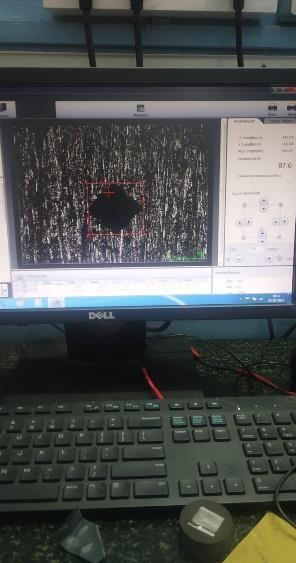
Here,themufflefurnacewas utilizedfor theheattreatmentprocedure. Thefabricatedcomposites weresubjected to heat treatmentatdifferentlevelsoftemperaturesandtimeintervals.Thespecimensare wrappedinaluminiumfoilandplaced insidea ceramicbowltoprevent theformationofanoxidelayeronthespecimensurfacebeforebeingputinthefurnace. Laterthespecimenswereplacedinsidethefurnaceforheattreatment.Theagingtreatmentwasconductedatthreedistinct temperatures(150o ,175oand200o),andvaryinglengthsoftime(between2and8hours).Afterwhichthespecimenswere takenout and quenchedinthe quenching medium. Water kept at roomtemperaturewas usedas thequenchingmedium. Afterbeingaged,thespecimenswerepolished,andVickers'hardnesstestwasconductedandthetestresultswereobtained todeterminetheimpactofheattreatmentoncomposites.

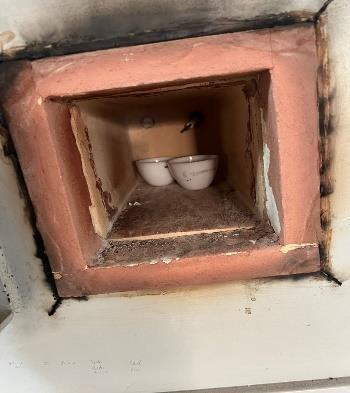
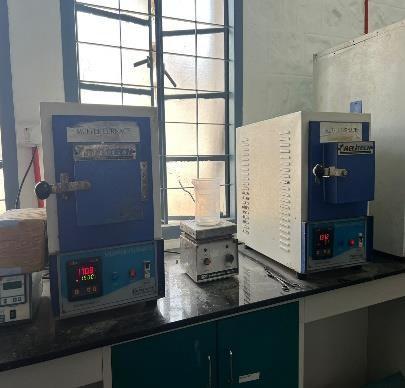

Heat treatment processes can significantly alter the properties of a material, including its hardness. Therefore, it is important to perform hardness testing after the heat treatment process to ensure that thematerial meets the required specifications. Overall, hardness testing is an important step in ensuring that heat-treated materials meet the required specificationsfortheirintendedapplications.
Table2:Hardnessofheat-treatedAl7075alloyandcompositespecimensat150oC
Table2showsthehardnessvaluesofthespecimenssubjectedtoagingtreatmentat150 oC.Fromtheresults,itisevident thatthecompositespecimensrespondfastertoagingtreatmentthanalloys.Thiseffectisduetothepresenceofsecondary reinforcement particles such as silicon nitride and alumina particles in the matrix that acts as nucleation sites for the formation of precipitates during aging. Therefore, a higher percentage of precipitate particles can be formed in the compositespecimensthanintheAl7075alloy.Al7075+5%Si3N4&Al7075+2.5%Si3N4+2.5%Al2O3samplesshowed higherhardnessamongtheanalyzedspecimensofabout103&101HVafteragingtreatment.Theformedprecipitatesalso actasbarrierstodislocationmotionandthuscontributetothehardeningofthealloy.
The hardness values after aging the samples at 175 oC are shown in Table 3. The reading shows that when Al7075 composites are aged at 175 oC, the rate of precipitation in the matrix is faster as comparedto aging at 150 oC. Al7075 + 5%Si3N4samplesshowahardnessvalueofabout88HVwhenagedat 150oCfor2hours,whereasitshowsahardnessof
about105.3HVwhen agingis doneat 175 oC. Similarobservations are noticed in analyzed samples in all the composite samples.TheeffectoftemperatureduringagingisnotsignificantinAl7075alloyincomparisontoAl7075composites.The maximumhardnessachievedforAl7075alloysafteragingat175 oCis98HV.Al7075+2.5%Si3N4+2.5%Al2O3showeda maximum hardness of about 119.6 HV after aging at 175 oC for 8 hours. The presence of hybrid reinforcements like alumina&siliconnitrideaidintheformationofprecipitatesduringaging.
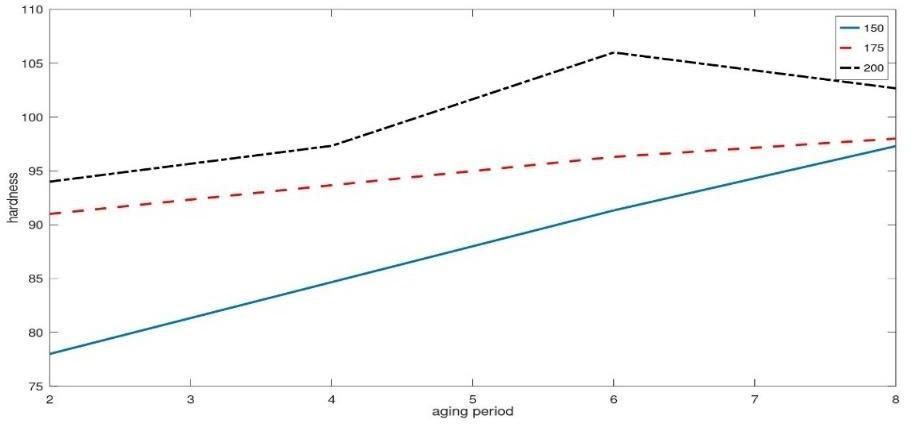

Table4:Hardnessofheat-treatedAl7075alloyandcompositespecimensat200oC
FromTable4,thepeakhardnessachievedforbothAl7075alloyanditscompositesisafter agingfor6hoursat200 oC.The hardnessvaluesstarttodecrease whenagingisdonebeyond6hours,leadingto overagingphenomenon. The aging was notnoticedinthe150oCand175oCduetothelowertemperatureThereforetheagingtimedurationhastoberestrictedto 6hourswhenagingisdoneat200oCtoachievemaximumhardnessvalues.Fromtheresultsobserved,itcanbeconcluded that Al7075 + 2.5%Si3N4+2.5%Al2O3compositeshows a maximum hardness of123.7HVwhenagingheattreatmentis doneat200 oCfor6hours,Thisagingtemperatureof200 oCfor6hoursistheoptimumagingcycleforbothAl7075alloy and silicon nitride, alumina reinforced composites and hybrid composites resulted in superior hardness value when comparedtotheothercomposites.
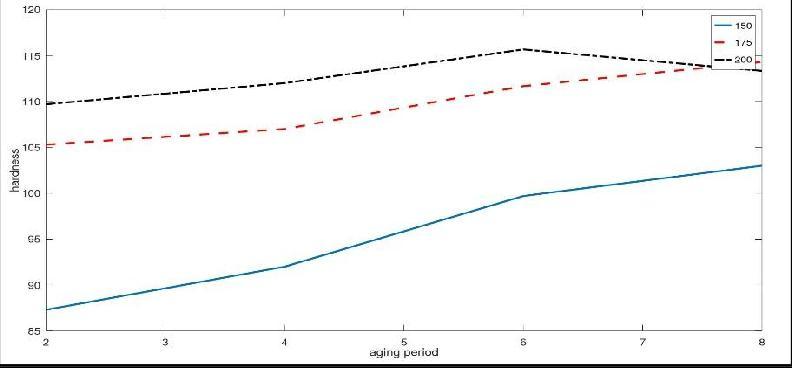

Aweartestonapin-on-weardiscapparatusisamethodusedtoevaluatethewearresistanceofmaterials.Theweartestis carried out at 20 N load with a sliding distance of 1000m and 300 rpm. It iswell known that hardness is directly proportional to wear resistance (i.e. higher the hardness, the higher the wear resistance). Since the hybrid composite (Al7075 + 2.5%Si3N4 + 2.5%Al2O3) portrays superiority in terms of hardness, its wear characteristics were evaluated specifically.ThewearstudiesoftheagedspecimenforAl7075+2.5%Si3N4+2.5%Al2O3 sampleisshowninFig15.

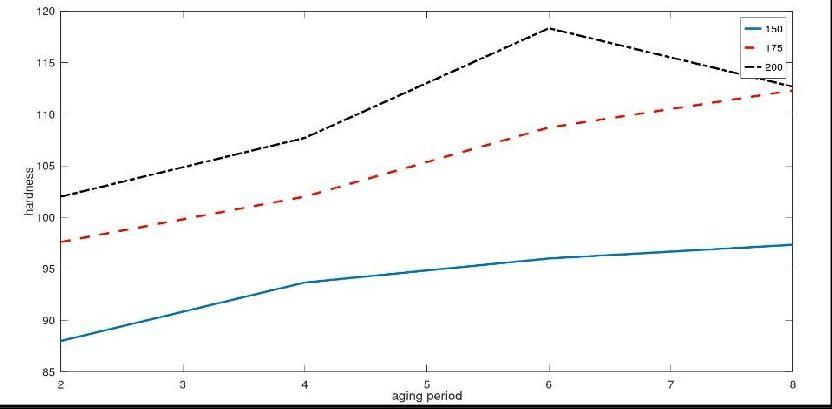

The hardness of Al7075 composite specimens reinforced with silicon nitride and alumina possesses higher hardness, ComparedwithAl7075alloythisisduetothepresenceofhardceramicreinforcementsinthematrix.Theoptimumcyclefor heat treatment of Al7075 hybrid composites is aging at 200 oC for6 hours. The rate of precipitation during aging is significantly higher in Al7075 composites in comparisonwithAl7075alloyandthehybridcompositewith2.5%ofsilicon nitrideand2.5 %aluminareinforced Al 7075 composite exhibited a higher response to aging treatment and resulted in maximumhardnessofabout123.7HV.
[1] S.ArunKumar,J.HariVignesh,andS.PaulJoshua,“Investigatingtheeffectofporosityonaluminium7075alloy reinforcedwithsiliconnitride(Si3N4)metalmatrixcompositesthroughtheSTIRcastingprocess,” Mater. Today Proc.,vol.39,no.xxxx,pp.414
419,2020,doi:10.1016/j.matpr.2020.07.690.
[2] R.K.Nagula,“OPTIMIZINGWEARBEHAVIOROFHYBRIDAL7075,”vol.7,no.15,pp.6341–6357,2020.
[3] J.M.MistryandP.P.Gohil,“ExperimentalinvestigationsonwearandfrictionbehaviourofSi3N4preinforcedheattreatedaluminiummatrixcompositesproducedusingelectromagneticstircastingprocess,” Compos. Part B Eng., vol.161,pp.190–204,2019,doi:10.1016/j.compositesb.2018.10.074.
[4] P.S.RaghavendraRaoandC.B.Mohan,“Studyonmechanicalperformanceofsiliconnitridereinforcedaluminium metalmatrixcomposites,” Mater. Today Proc.,vol.33,no.xxxx,pp.5534–5538,2020,doi: 10.1016/j.matpr.2020.03.495.
[5] A.Pramanik,“Effectsofreinforcementonwearresistanceofaluminummatrixcomposites,”Trans. Nonferrous Met. Soc. China (English Ed.,vol.26,no.2,pp.348–358,2016,doi:10.1016/S1003-6326(16)64125-0.
[6] E.Rajkeerthi,C.P.Satyanarayan,M.Jaivignesh,N.Pradeep,andP.Hariharan,“Effectofheattreatmentonstrengthof aluminiummatrixcomposites,” Mater. Today Proc.,vol.46,no.xxxx,pp.4419–4425,2019, doi:10.1016/j.matpr.2020.09.672.

[7] R.Pramod,G.B.VeereshKumar,P.S.S.Gouda,andA.T.Mathew,“AStudyontheAl2O3reinforcedAl7075Metal MatrixCompositesWearbehaviorusingArtificialNeuralNetworks,” Mater. Today Proc.,vol.5,no.5,pp.11376
11385,2018,doi:10.1016/j.matpr.2018.02.105.
[8] A.Lakshmikanthan et al.,“Theeffectofheattreatmentonthemechanicalandtribologicalpropertiesofdualsize SiCreinforcedA357matrixcomposites,” J. Mater. Res. Technol.,vol.9,no.3,pp.6434–6452,2020,doi: 10.1016/j.jmrt.2020.04.027.
[9] H.I.Akbar,E.Surojo,D.Ariawan,andA.R.Prabowo,“ExperimentalstudyofquenchingagentsonAl6061–Al2O3 composite:Effectsofquenchingtreatmenttomicrostructureandhardnesscharacteristics,” Results Eng.,vol.6,no. December2019,p.100105,2020,doi:10.1016/j.rineng.2020.100105.
[10] F.Chemmala,M.Anoop,P.Sinesh,S.Pc,andA.R Ek,“StudytheMechanicalBehaviourofAl7075withSiliconNitride byComputerAnalysis&StirCasting,” Int. J. Innov. Sci. Res. Technol.,vol.6,no.6,pp.293–296,2021.
[11] S. K. Tiwari, S. Soni, R. S. Rana, and A. Singh, “Effect of Heat Treatment on Mechanical Properties of Aluminium alloy-Fly ash Metal Matrix Composite,” Mater. Today Proc., vol. 4, no. 2, pp. 3458–3465, 2017, doi: 10.1016/j.matpr.2017.02.235.
[12] K.H.W.Seah,“compositespropertiesofas-castandZA-27/graphiteparticulate,” Compos.Part A Appl. Sci. Manuf., pp.251–256,1997.
[13] E. Subba Rao and N. Ramanaiah, “Influence of Heat Treatment on Mechanical and Corrosion Properties of AluminiumMetalMatrixcomposites(AA6061reinforcedwithMoS2),” Mater.Today Proc.,vol.4,no.10,pp.11270–11278,2017,doi:10.1016/j.matpr.2017.09.050.
[14] R.Yamanoĝlu,E.Karakulak,A.Zeren,andM.Zeren,“EffectofheattreatmentonthetribologicalpropertiesofAl-CuMg/nanoSiCcomposites,” Mater. Des.,vol.49,pp.820–825,2013,doi:10.1016/j.matdes.2013.02.026.
[15] R.R.Veeravalli,R.Nallu,andS.MohammedMoulanaMohiuddin,“Mechanicalandtribologicalpropertiesof AA7075-TiCmetalmatrixcompositesunderheattreated(T6)andcastconditions,” J. Mater. Res. Technol.,vol.5,no. 4,pp.377
383,2016,doi:10.1016/j.jmrt.2016.03.011.
[16] C.Velmurugan,R.Subramanian,S.Thirugnanam,andB.Anandavel,“Investigationoffrictionandwearbehaviorof hybridaluminiumcomposites,” Ind. Lubr. Tribol.,vol.64,no.3,pp.152–163,2012,doi: 10.1108/00368791211218687.
[17] M.Winnicki,M.Jasiorski,A.Baszczuk,andM.Korzeniowski,“Heat-treatmentofaluminium-nickelcompositecold sprayedcoating,” Coatings,vol.10,no.6,pp.1–15,2020,doi:10.3390/coatings10060581.
[18] M.J.Tan,L.H.K.Ka,K.Y.Murakoshi,andT.Sano,“MaterialsProcessingTechnologyHEATTREATMENTSIN ALUMINIUM-LITHIUMCOMPOSITESEXTRUSION,”vol.48,no.1995,pp.747–755,1995.
[19] H.GowdaandP.R.Prasad,“InfluenceofHeatTreatmentonCorrosionResistanceofA356/RHA/Al2O3Based HybridComposites,” Mater. Today Proc.,vol.4,no.10,pp.10870–10878,2017,doi:10.1016/j.matpr.2017.08.041.
[20] N.C.KaushikandR.N.Rao,“TheeffectofwearparametersandheattreatmentontwobodyabrasivewearofAl-SiCGrhybridcomposites,” Tribol. Int.,vol.96,pp.184–190,2016,doi:10.1016/j.triboint.2015.12.045.
